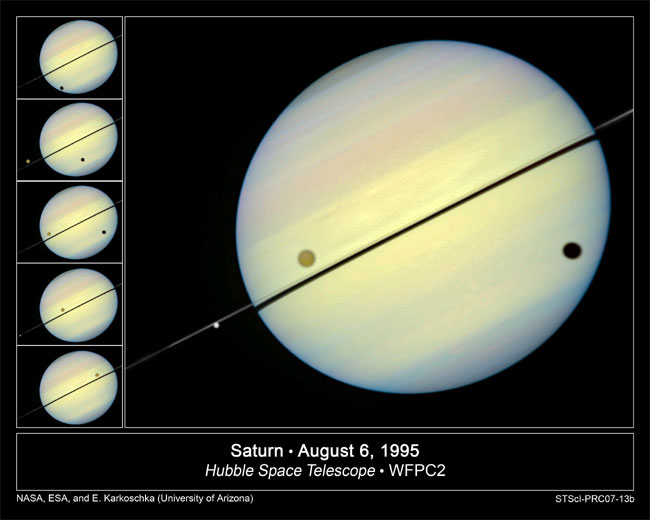Hubble Catches Saturn's Orbital Dance in New Movies

Astronomershave created three stunning movies of Saturnand its rings, using special techniques to extend still images taken by the Hubble Space Telescopeinto moving pictures that show the ringed planetin novel splendor.
Each moviehighlights a different moment in the planet's 30-year orbit around the Sun.
- VIDEO: Hubble Space Telescope's Saturnian Movies
Two of themovies (15 seconds long and 30 seconds long) show the motion of several ofSaturn's moons when the planet's rings were tilted nearly edge-on towards the Earth and Sun. Such alignments happenabout once every 15 years. The third movie, at 24-seconds long, shows a clearview of Saturn's southern hemisphere when the planet's rings were most tiltedtoward Earth.
Ray Villardof the Space Telescope Science Institute (STScI),which oversees the Hubble space telescope's research mission, said the moviesshow Saturn at very unique orientations relative to Earth.
"WhenSaturn's ring plane was edge-on to earth, the ring becomes a wafer-thin sliceand that's a beautiful opportunity to see the moons very clearly," hesaid.
Another setof images used for the videos and from a similar orientation also impressedfolks at STScI immediately, Villard said."What's spectacular about that, which we noticed when the pictures firstwere taken, is that you can actually see the shadow from the moon skirtingacross the ring plane," he told Space.com. "That would onlyhappen at a unique time, just like a setting sun."
Software wasused to morph a dozen images, during each of these orbital slices of time, intothe hundreds of images needed for the movies.
Breaking space news, the latest updates on rocket launches, skywatching events and more!
The imageswere taken by the Hubble's Wide Field Planetary Camera 2 in 1995 and the Advanced Camerafor Surveys in 2003.
Moviedetails
Theshortest edge-on ring movie shows the moons Titanand Tethysorbiting Saturn. The moons follow the rings' thin line in their orbit aroundSaturn. Titan's shadow is the first to appear, moving across Saturn's disk.Titan follows, with Tethys appearing on the left from behind the planet. Themoons seem to move much faster than they actually do because several hours ofviewing time (images were taken over a 10.5-hour span) were compressed to makethe movie, which also shows bands of clouds that make up Saturn's atmosphere.
The longeredge-on ring movie shows the icy moons Mimas, Enceladus, Dione and Tethysrounding Saturn. Enceladus appears first with Mimas right behind. Both moons cast small shadows on theplanet, and Enceladus casts a shadow on the rings. Mimas' orbit is too inclined to hit the rings. Dione then appears with a long shadow that tracksacross the ring system. Tethys appears only briefly as it moves behind theplanet on the right. The images for this movie were taken over a 9.5-hour span.
The maximumring-tilt movie first shows Saturn spinning. Although the rings rotate with theplanet, they appear to be stationary because the ring material is spread out soevenly. Saturn rotates on its axis every 10 hours, more than twice as fast asEarth.
Next, themovie offers a close-up of Saturn's southern hemisphere. Astronomers enhancedthe contrast in this sequence to make Saturn's banded cloud structure moreobvious. The images for this movie were taken over a 24-hour span.
NASA's Voyagerand Cassini missions also have generated movies of Saturn. Cassini has been atSaturn since July 2004, studying the planet, its moons and its ring system.
"Cassinihas shown us those moons are so diverse that it's like finding a little solar systemunto itself," Villard said.
- VIDEO: Hubble Space Telescope's Saturnian Movies
- VIDEO: The Cassini Probe Crosses Saturn's Rings
- VIDEO: Enceladus - Saturn's Old Faithful
- The Best Hubble Space Telescope Images
- Complete Coverage of the Hubble Space Telescope
- Hubble Gets Superb View of Saturn and Rings
- IMAGES: New Snapshots of Saturn
- IMAGES: Imagining Saturn and Titan
- All About Saturn

Robin Lloyd was a senior editor at Space.com and Live Science from 2007 to 2009. She holds a B.A. degree in sociology from Smith College and a Ph.D. and M.A. degree in sociology from the University of California at Santa Barbara. She is currently a freelance science writer based in New York City and a contributing editor at Scientific American, as well as an adjunct professor at New York University's Science, Health and Environmental Reporting Program.
